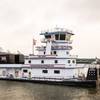It was hot. Really hot, the smoke was getting denser by the moment as the fire grew larger. It was getting darker. I couldn't see the flames any more from my position on the hose line but I could certainly feel the heat. We were close
"Here it comes," announced Todd Duke, the instructor leading my team into hell. All of a sudden the compartment lit up as a ball of flames raced across the overhead. The heat was intense. Two quick bursts from the nozzle, more darkness. The steam created made an evil hissing noise. I had just experienced my first flashover. I was beginning to wonder why I had chosen this line of work.
Our instructor is telling us this is what we don't want to happen onboard our vessels. The overhead flashes over again. Two more bursts of water. This time the team makes a direct attack, water right onto the seat of the fire. More steam is produced. The visibility is poor. One of my team member's speaks to me. I can hardly hear him. The SCBA muffles his voice.
The fire is crackling and the steam is hissing. Todd explains a combination attack, and the reasons we don't want to just spray water onto a fire.
"You have to keep the heat and smoke in the ceiling, you have to control your steam production or you will boil yourself like a Louisiana Crawfish," he says. Then he proved it to us.
Spraying just enough water to bring the steam and smoke on top of us, I feel the heat rise and see the visibility go to nothing. My breathing increases, I am nervous but I take comfort in the professionalism demonstrated by the staff. It's total darkness and the heat is unbelievable. No one would survive this without the protective clothing and SCBA we are wearing. Todd orders us to back out of the compartment. I just lived through 20 minutes of hell.
I was in my second day of the USCG Basic and Advanced Fire Fighting course at Resolve Fire & Hazard Response, Inc. located in Fort Lauderdale, Fla. When I experienced my first flashover. I had submitted my paperwork to the USCG-MSO to get my 500-ton Masters license. The MSO told me I had to take a fire-fighting course. I guess when you really think about it there isn't anyone but your crew to fight the fire when you're at sea. Calling 911 just does not work at sea.
The first day had been spent in the classroom learning about fire prevention and why fires burn. We were also taught about different portable fire extinguishers and extinguishing agents. We took a tour of Training Vessel Gray Manatee. This was to be our ship for the next week. The training vessel is 140 ft. long, 48 ft. wide and three decks tall.
I had chosen to go to Resolve Fire & Hazard Response, Inc. because the vessel is built like a real ship. It has real engines, doors, hatches, and other items you would find only on a ship. The vessel also has the only flashover simulator built into a vessel for marine fire training.
We were shown the safety features and emergency exits, the areas where the fires would be, and then given the assignment to create a fire plan. Troy Parker, a licensed 1,600-ton Master and former fire officer, relayed to us how important it is to preplan your vessel.
During the morning of the second day, Troy assigned the class to teams. We would become a cohesive fire-fighting unit by the end of the week. We were fitted for bunker gear and shown how to use the SCBA. I remember thinking there sure was a lot to remember when using this equipment. Those thoughts did not go unnoticed as Lt. Ed Parker, a fire officer with the Port Everglades Fire Department and a Staff Instructor at Resolve, pointed out how important it is to run realistic fire drills onboard the vessel.
"These drills will help you learn to use your equipment effectively and to do so quickly. Additionally you will be able to combat the fire more quickly," says Ed.
Todd was quick to add it is "better to be safe than soggy," his favorite expression to point out if you don't put out the fire then you're going to have to abandon ship.
In addition to the flashover simulator on the second day, the instructors taught us proper hose handling procedures, use of portable fire extinguishers, proper watertight door and compartment entry, SCBA use and hose handling.
The third day was pure murder. I was learning how out of shape I was. We spent all day on the vessel. I began yearning for the air-conditioned comforts of the classroom. They say experience is the best teacher though, and I was getting plenty of live fire fighting experience. We made entry back into the flashover chamber down a vertical ladder. Then into the flashover chamber again using a regular stairwell. I had participated in many drills onboard the vessel before but we always attacked the fire using a 'dry" hose. There is so much difference in trying to move a dry hose and one that is filled with water, especially when there is lots of heat and smoke present.
Our team was then assigned search and rescue. The instructors took us to the cabin area where we had to search four cabins and a passageway to find a 160 lb. mannequin. After we found the mannequin we had to figure out how to get him to fresh air. I just then realized how heavy 160 lbs. is.
The afternoon was spent fighting engine room fires, learning how to ventilate, and fighting flammable liquid fires. Kevin Kenney, the Facility Maintenance Manager made sure we always had the right equipment and the fires were always built just right. He sure made them plenty hot. The flange fire gave me confidence in the ability to use water for protection. The staff brought us within one ft. of a fire that was producing over a million BTU's of heat per minute.
As we progressed through the days, I realized the instructors would teach use something new and that concept would build upon previous scenarios we had been through. More homework was assigned.
Thursday was practical assessment day. With STCW-95 regulations in place, I must prove I am competent in certain areas. The staff at Resolve Fire doesn 't just sign people off. Our team had to formulate a plan. The staff gave us a scenario. The instructors then went and lit fires. My team had two interior fires to extinguish, we had to perform a search and rescue, set fire boundaries, and we had to ventilate. I went through two cylinders of air during the assessment exercise. I learned a lot about team management through that exercise.
We had a classroom session where we spent about two hours discussing strategy and tactics. Many fire scenarios were presented. The group discussion really opened my eyes to problems I had not thought of before.
Thank goodness it's Friday. Today I graduate, if I pass the written exam; but first, more classroom sessions. We discuss fixed fire systems, ship construction and how it affects the fire fighting effort. One of the most interesting classes was the module on stability and buoyancy. It wasn't the same old center, Meta center, G curve stuff. Resolve Fire's parent company also operates a marine salvage company. We saw a video of a ship listing and ultimately sinking at the dock. Then we saw video of the ship being raised. A lot of the dry concepts were really brought to my attention by seeing it in action.
I was totally amazed by the professionalism I had found. These guys at Resolve Fire and Hazard Response, Inc. didn't just cover what was required. They brought the realism from actual ship fire fighting and salvage experience to the classroom and the field. I guess I should have expected this once I saw T/V Gray Manatee.
I had come to Resolve Fire & Hazard Response, Inc. seeking a certificate that would satisfy the USCG, I left with an education that will last a lifetime.
Subscribe for
Maritime Reporter E-News
Maritime Reporter E-News is the maritime industry's largest circulation and most authoritative ENews Service, delivered to your Email five times per week









